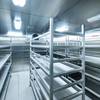ABS has granted extended general design approval for the KC-1 LNG cargo containment system (CCS). The new membrane type will be installed on newbuild LNG carriers currently on order for Korea Gas Corporation (KOGAS), the world's largest LNG importer.
The new LNG CCS design is a corrugated membrane type based on KOGAS' membrane containment system technology used for land-based LNG storage tanks. KOGAS developed the design concept for the KC-1 CCS in cooperation with the DSME, Samsung Heavy Industries and Hyundai Heavy Industries shipyards based in South Korea.
Beginning in 2005 and expanded in 2008 and 2013 to cover additional components, the work scope by ABS was extended to include a sloshing evaluation using sloshing model tests as part of the structural strength assessment of the new CCS type. The associated pump tower design and sloshing analyses have been reviewed in accordance with the ABS Guidance Notes on Sloshing and Structural Analysis of LNG Pump Tower, the ABS Guidance Notes on Strength Assessment of Membrane-Type LNG Containment Systems under Sloshing Loads and other applicable industry standards. In the final assessment of the containment system, ABS analyzed tank and ship motions, including the sloshing impact and fatigue loading, on an LNG carrier operating in North Atlantic wave conditions.
"We are pleased to extend general design approval to KOGAS for this innovative LNG cargo containment system," said Dr. Hoseong Lee, ABS Vice President of Global Korea Business Development. "To support the safe emergence of the LNG market, ABS will continue to provide technical support to designers, shipowners and operators to achieve regulatory compliance and operational safety. This new membrane-type cargo hold system will be equipped to support the safe storage and transportation of LNG."
According to KOGAS, the basic concept of the KC-1 system is to minimize the effect on the insulation system by the hull and primary barrier deformation. The new system will use a 1.5-mm thick corrugated stainless steel 304L membrane as the primary and secondary barriers and polyurethane foam having a density of 115 kg/m3 as the insulating material. The proprietary membrane containment system technology has been tested for performance and reliability in cryogenic operating conditions and is being applied to 200,000 m3 in-ground LNG storage tanks in the KOGAS Incheon LNG Receiving Terminal.
"We are delighted to have been granted final design approval by ABS for the KC-1 LNG containment system," said KOGAS Executive Vice President and CTO of R&D, Dr. Young-Myung Yang. "We have been working closely with ABS for nearly a decade to conduct preliminary safety reviews and obtain design approval for this new LNG technology, which will be installed on recently ordered newbuild LNG carriers."













